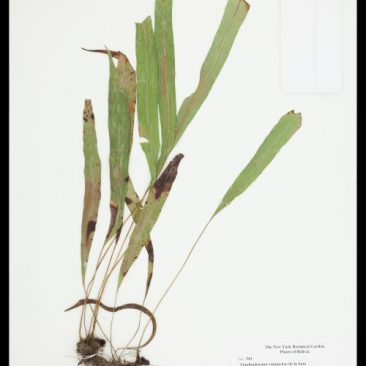Elaphoglossum – the deer tongue ferns
Alejandra Vasco & Robbin Moran
With approximately 600 species, Elaphoglossum (Dryopteridaceae) is one of the most diverse genera of ferns (Mickel, 1995). It has a pantropical distribution, occurring principally in wet-montane and cloud forests. The center of diversity is tropical America, which harbors ca. 450 described species (Mickel, 1990). Other centers of diversity are Africa and Madagascar (ca. 70 species), and Southeast Asia (ca. 50 species) (Rouhan, 2005).

Distribution of the genus Elaphoglossum
Elaphoglossum poses some interesting challenges at the taxonomic level, because it is a large genus, its species are similar, and the characters that distinguish them are typically few and subtle. There have been several attempts to split Elaphoglossum in smaller groups to make it more manageable taxonomically (Fée 1845; Sodiro 1893; Christ 1899; Mickel and Atehortúa 1980). The most recent and comprehensive of these (Mickel and Atehortúa 1980), recognized 9 sections and 21 subsections. More recently phylogenetic molecular analyses have shed some light into the relationships within Elaphoglossum (Rouhan et al. 2004; Skog et al. 2004), and have clearly supported five of the nine sections originally proposed by Mickel and Atehortúa on the basis of morphology.
The main goal of this website is to make available in a single location all the information that we and our collaborators have accumulated on the taxonomy and biology of the genus. We will start by providing information about the taxonomic history, synonyms, morphology, diagnostic features, distribution, phylogenetic hypotheses, photos and specimens (mainly the ones hosted at NY, but also from other herbaria) of some groups with which we are currently working. We will include keys to species (not yet available), web pages for each species, and copies of papers that have been written about Elaphoglossum.
The primary reason for this web site is to make it possible for other researchers and persons interested in Elaphoglossum to know the names of species of the genus and to learn how we and others have used this information to learn about their biological relationships. We want to make available the information and the images that we have collected aboutElaphoglossum to current botanists with the hope that this will facilitate collaboration and stimulate research. As we study different species of Elaphoglossum, we will provide on this site information about how to identify the species, their biogeography, character evolution, dispersal, habitat preferences, and phylogenetic relationships. This information can be used to understand biological processes and to design conservation plans for protecting species of Elaphoglossum and other species that share their habitats.


